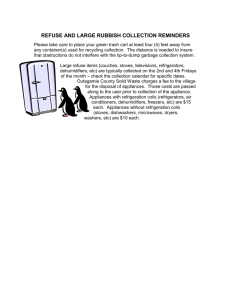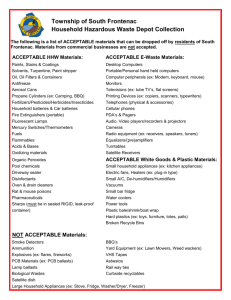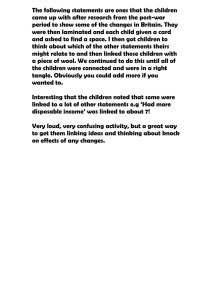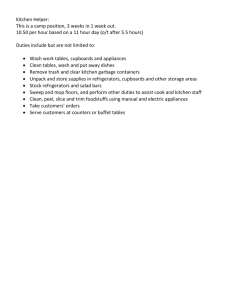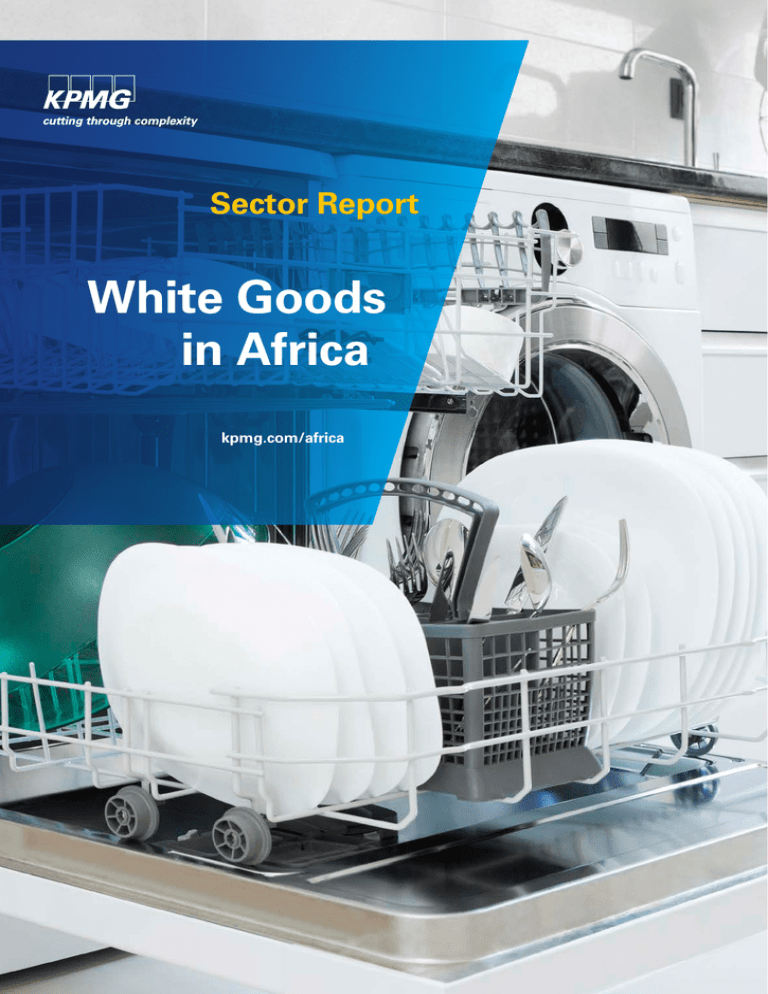
Sector Report
White Goods
in Africa
kpmg.com/africa
The series has the following reports:
• Private Equity in Africa
• Construction in Africa
• Insurance in Africa
• Power in Africa
• Healthcare in Africa
• Banking in Africa
• Manufacturing in Africa
• Fast-Moving Consumer Goods in Africa
• Luxury Goods in Africa
• The African Consumer and Retail
• Life Sciences in Africa
• Agriculture in Africa
Table of Contents
Introduction & Overview1
Manufacturing & Exports2
South Africa3
Egypt4
Tunisia5
Major Household Appliances: Largest Markets6
Nigeria7
Egypt8
South Africa9
Morocco10
Ethiopia11
Kenya
11
Ghana11
Ivory Coast13
Final Thoughts14
Sources of Information16
Contact Details17
1 | White Goods in Africa
Introduction & Overview
Africa is currently home to one billion people,
presenting a massive potential consumer market.
Furthermore, the continent’s population will surpass
the 1.5 billion mark by 2026 and the two billion
mark 15 years later. The strong growth in African
consumer spending over the past decade and
the positive outlook for demographic dividends
over the coming decades is part of the consumer
evolution story that is perennially talked about in
African business and investment circles. Africans
are increasingly moving to cities, making it easier
for companies to target certain consumer groups.
Admittedly, Africa’s retail sector remains relatively
under-developed at present, with most shopping
still being done at traditional shops and markets. The
formalisation of retail activities – already underway –
will be a key trend underlying the sector’s expansion
in the coming decade. Another key challenge for
retailers and white goods sellers in particular is
the high levels of poverty on the continent. Most
of Africa’s consumers are extremely poor, and
spend the majority of their money on food and
other necessities – the acquisition of household
furniture and appliances accounts for only around
5% of household expenditure. Nonetheless,
the continent’s middle class (those households
spending more than US$3,000 per annum) totals
almost 40 million.
This report will firstly look at the continent’s major
manufacturers and exporters of white goods (South
Africa and Egypt, and to a lesser extent Tunisia).
Secondly, based on imports and market size data,
the following major white goods markets will be
reviewed: Nigeria, Egypt, South Africa, Morocco,
Ethiopia, Kenya, Ghana, and Ivory Coast.
White Goods in Africa | 2
Manufacturing & Exports
There are many reasons why Africa’s manufacturing
sector is under-developed: limited access to effective
and efficient labour; inadequate infrastructure; armed
conflict, corruption and instability not being conducive
to long-term capital investments; rising fuel and
electricity prices (and associated issues with reliability
of supply); competition with Asian and developed world
counterparts; a shortage of domestic suppliers of inputs;
and the high costs of importing and exporting goods,
amongst other issues. Manufacturing exports account
for around a quarter of the continent’s export revenues
compared to a figure of 75% for East and South Asia.
Nonetheless, there are more than a handful of countries
on the continent that rely on manufacturing for a notable
part of their overall economic activity. These economics
include (in alphabetical order. Algeria (oil refining,
gas and food processing); Angola (oil refining); Egypt
(textiles, cement products and automobiles); Ghana
(aluminium smelting, cement, and agro-processing);
Kenya (food canning, grain milling and sugar refining);
Libya (oil refining, food and fertilisers); Morocco (textiles,
electronic goods and automobiles); Nigeria (oil refining
and cement); South Africa (energy and metal products);
Swaziland (textile-related products), Tanzania (food and
beverages); Tunisia (key industries include mechanical
and electronic goods, textiles and agro-processing); and
Uganda (agro-processing). There is no African country
very dependent on the production of white goods. South
Africa and Egypt represented the only two economies
with major excess production of certain white goods and
accounted for 87% of Africa’s white goods exports during
2011-13. When adding Tunisia, this figure increases to
90%. Namibia and Swaziland combined accounted for a
further five percentage points of these shipments, while
the addition of Kenya and Morocco sees these seven
economies representing almost 97% of white goods
exports. Over the past five years, some three-quarters of
these exported goods (by value) were cooling equipment:
refrigerators & freezers and air conditioners. White
goods exports as calculated in this report were valued
at an average of US$470m during 2011-13. However,
this represented less than 0.1% of the continent’s total
export revenues for the period.
3 | White Goods in Africa
South Africa
The South African government is keenly focused
on factories and heavy industry as an employment
creator based on the observed horizontal and
vertical impacts of these industries on growth and
employment in other sectors. Africa’s secondlargest economy is amongst the continent’s best
performers (alongside Mauritius, Morocco, Kenta,
Tunisia and Rwanda) when considering features
such as the quality of overall infrastructure, workers’
pay versus productivity, local supplier quantity
and quality, the state of cluster development, and
value chain breadth. Nonetheless, South Africa’s
factory sector – and in particular those involved in
intermediate technology goods – faces several key
challenges at present: a shortage in and the high
cost of skilled labour, constraints on energy supply,
and competition from Asian companies both in the
domestic and international market. Calculations
based on data from Statistics South Africa (StatsSA)
indicated that household appliances represented
0.75% of the physical volume of factory production
in the country during 2014 – similar to the level seen
in 2011. The country’s kitchen appliance exports
are dominated by refrigerators and freezers: 70%
of South Africa’s white goods shipments during
2011-13 came from this category. From a company
perspective, Defy Appliances (part of the Koç Holding
industrial conglomerate, a Fortune Global 500
company) is the largest manufacturer and distributor
of major domestic appliances in Southern Africa, with
factories in Durban, Ladysmith and East London – the
latter two facilities being home to the company’s
refrigerator and freezer production. The company
has agents in Botswana, Namibia, Swaziland, Zambia
and Zimbabwe and sells goods under the Defy
and Ocean brands. Hisense South Africa produces
consumer electronics and home appliances at its
facility in Cape Town (opened during June 2013) and
exports these products to Southern African countries
as well as Ghana, Liberia and Cameroon. Whirlpool
SA distributes household appliances to the South
African market and a selection of other countries on
the continent, including locally-produced goods under
the KIC brand.
Koç Holding Chairman Mustafa Koç said during
November 2014 that he would like to see South
Africa be established as a white goods export hub
much as the country is seen as an automotive hub.
Following his company’s US$324m acquisition
of Defy during 2011, reported to be the largest
investment ever by a Turkish company into Africa,
Koç Holding set in motion plans to upgrade the
South African manufacturer’s facilities in order
to increase its exports into sub-Saharan African
(SSA) markets. According to Engineering News,
renovation of the Jacobs facility in Durban (key
products include stoves, build-in ovens and air
conditioners) and the establishment of two more
production lines at the Ezakheni facility in Ladysmith
(key products include refrigerators and freezers)
was completed within the first two years after
the buyout. A three-year, US$50m expansion plan
raised Defy’s output by more than 30% and included
technology transfer from Turkey. This, according
to South African trade and industry minister, Rob
Davies, is in line with the country’s Industrial
Policy Action Plan (Ipap). Mr Davies sees the white
goods industry as “strategic” for the country’s
manufacturing sector: “Hence we developed
a white goods strategy with key interventions
of upgrading the technology and meeting the
environmental imperatives,” said the minister.
White Goods in Africa | 4
Egypt
The local factory sector struggled during 2011-12
as political and labour unrest made it impossible
for many factories to work at full capacity while
many others were closed down. The situation
looked somewhat better in 2013, though on-going
protests, a shortage of foreign currency (at times),
as well as a cut in state energy subsidies to some
industries weighed on production. During 2014, the
manufacturing industry rebounded strongly as the
security situation improved and as billions of dollars’
worth of aid from Gulf Cooperation Council (GCC)
countries eased the country’s foreign-exchange
shortages. During the 2011-14 period, around
three-quarters of Egypt’s manufactured goods were
exported to Europe, while white goods were mostly
sold to countries in the Middle East and elsewhere
in North Africa. Almost 55% of white goods are
classified as stoves, ovens & grills: the value of
these exports increased by an average of more than
20% p.a. during 2010-12 in spite of the country’s
political situation. Data from the Central Bank of
Egypt (CBE) indicates that the country produced
nearly 1.2 million washing machines and the same
volume of refrigerators during the 2011/12 (July
– June) financial year – this is the latest available
data. Unit output of these two categories of goods
increased by an average of 4.2% p.a. during the
2002/03 – 2011/12 period, and by a mean of 4.7%
p.a. when excluding the troubled 2010/11 period.
While exports are important to the local industry,
a great number of these units were destined for
the domestic market. The Kiriazi Group considers
itself “the most important group of companies
producing home appliances in Egypt and in the Arab
World,” with five factories producing refrigerators
and freezers, washing machines, and gas cookers.
Four of these factories are situated in Obour City
(35 km north-east of Cairo). In turn, global appliance
manufacturer Electrolux referred to the Olympic
Group as Egypt’s “leading appliance manufacturer”
during 2011 in documentation relating to the
acquisition of the Egyptian company. The Olympic
Group sells refrigerators, laundry washing machines,
ovens, microwaves and other products, of which
98% are manufactured by the organisation. The
company’s wholly-owned wholesale trader EPA is
the largest white goods trader in Egypt.
5 | White Goods in Africa
Tunisia
The manufacturing sector (accounting for 16% of
GDP during 2014) remains of critical importance to
the Tunisian economy, and factory goods produced
are mainly aimed at exporting to European markets.
The sector’s growth over the past decade has
mainly been driven by the mechanical and electrical
equipment industry: the main exports in the
mechanical & electrical industry are wiring, cables
and cable harnesses; electrical command apparatus;
transformers; printed circuits; and refrigerators.
According to the Foreign Investment Promotion
Agency (FIPA), there were 824 companies focused
on mechanical and metallurgical production during
2014 and 454 companies associated with electrical
& electronic industries (including household
appliances). Around a third of these enterprises are
fully export oriented. Trade Map data indicates that
the country’s exports of major kitchen appliances
averaged US$18m p.a. during 2002-08 followed
by a negative trend in the following three years (in
the aftermath of the global financial crisis) to just
US$10m during 2011. Export values similar to the
pre-2009 period were again seen during 2012-13.
From a GDP perspective, the World Bank estimates
that the manufacturing sector contracted by 1.4%
during 2009 (linked to the global financial crisis), and
again by 2.4% in 2011 (at the time of the Arab Spring).
China’s Haier Group – the world’s largest maker of
white goods – has a production site some 40 km from
the capital city of Tunis and produces refrigerators,
freezers, laundry washing machines, dish washing
machines, microwave ovens, and other appliances
for the domestic as well as export market.
White Goods in Africa | 6
Major Household Appliances: Largest Markets
cost of delivery and installation of the appliances when
applicable. Combined by household size data from
the ICF International, USAID and Euromonitor World
Factbook 2014 as well as population data from the
United Nations, this has allowed for the calculation of
the market size for major appliances in African countries.
Admittedly, the World Bank’s estimates of usage are not
complete, and exclude major economies such as Algeria
and Angola. As a result, the calculated total market size
of nearly US$40bn during 2010 for 35 African countries
should be seen as a minimum value. Nigeria offered the
largest market at US$18.7bn followed by South Africa at
US$13.7bn.
Based on country-specific survey/census data, the
World Bank offers information on the household usage
(measured in US dollar) of major appliances during 2010
(latest available data). This includes the five white goods
categories identified in the preceding text/graphs as well
as laundry dryers; drying cabinets; ironing and pressing
machines; humidifiers; heaters; ventilators and extractor
hoods; vacuum cleaners; steam-cleaning machines;
carpet cleaning machines; machines for scrubbing,
waxing and polishing floors; safes; sewing machines;
and knitting machines. The estimate also includes the
Regarding imports, more than 70% of the continent’s
white goods imports over the past five years have been
cooling equipment – refrigerators & freezers and air
conditioners. Cleaning appliances (laundry and dish
washing machines) represented almost 15% of imports
while cooking and heating equipment (stoves, ovens
& grills and microwave ovens) accounted for 13% of
imports. Eight countries – Algeria, Egypt, South Africa,
Nigeria, Morocco, Angola, Tunisia and Ghana, listed
by the value of their 2013 imports of white goods –
accounted for three-quarters of Africa’s white goods
imports. Algeria is now the largest market for white
goods imports.
7 | White Goods in Africa
Nigeria
Africa’s largest economy accounts for a fifth of
the continent’s total population and has a very
high potential for large demographic dividend. It is
therefore not surprising to learn that the country
received US$1.3bn worth of investment in its
retail sector during 2012-13, with retail activity
representing 16.4% of GDP during 2014. And
even though only a small proportion of Nigeria’s
population can as yet afford luxury products, this is
not an insignificant number of people in absolute
terms. The country has almost a million citizens
classified as middle class and almost 17,500 citizens
with investible assets of at least US$1m. Research
by Renaissance Capital indicates that 87% of
middle class households have a refrigerator and
four out of 10 have a combination refrigerator and
freezer appliance. The consumer story in Nigeria is
underpinned by many factors, including a large and
rising population, an increased rate of urbanisation
(currently around 50%), growing sophistication of
the retail market, and a burgeoning e-commerce
trend, amongst other factors. A recent improvement
in the prospects of the country’s electricity situation
is also a positive aspect in the outlook for white
goods sales. As part of a privatisation exercise,
the Nigerian electricity industry was unbundled
into generation and distribution companies and
a single transmission company. According to the
local statistics agency, Nigerian households already
spend around 5% of their budget on household
furniture and appliances. These Nigerians played a
role in increasing the country’s white goods imports
from around US$300m p.a. during 2008-09 to almost
US$600m by 2011, followed by an import bill of
US$400m p.a. during 2012-13. Cooling equipment
– refrigerators & freezers and air conditioners –
accounted for more than three-quarters of white
goods imports during 2011-13. Chinese companies
are the premier suppliers of these appliances.
White Goods in Africa | 8
Egypt
As the continent’s third-largest economy (ahead of
Algeria), it is not surprising that Egypt has in recent
years also been amongst the top three importers
of white goods. In fact, the value of these imports
surpassed that of South Africa during 2013 to place
Egypt second on the continent after Algeria – the
latter has seen its white goods imports double
from 2009 to 2013. A big factor in the country’s
overall import appetite for major appliances is its
large population of more than 83 million as well
as a large tourism market that welcomed almost
10 million international tourists during 2014. In
addition, based on population growth, the pace
of urbanisation and the changing landscape of
the median African age structure, Egypt has a
significant demographic potential – i.e. strong
growth prospects for consumer spending due to
demographically favourable developments. Already,
if five of Egypt’s governorates that make up most
of the desert area are excluded from consideration,
the remainder of the country is one of the most
densely populated regions in the world. Given this
exceptionally high concentration of people, retail and
other consumer-related investment opportunities
along the Nile are immense. In this regard, the
country is also seen as amongst the best prospects
for expansion in the demand for luxury goods, e.g.
products and services not essential to basic needs.
The country’s domestic market for major appliances
was already valued at US$2.3bn during 2010 and
white goods imports have since then increased by
at least 50%. (Key suppliers of Egypt’s white goods
imports include China, Italy, Thailand, Indonesia,
Malaysia, South Korea, and Turkey.) Admittedly,
there are some negative aspects to consider,
including ongoing political uncertainty, the relatively
small percentage of household spending towards
furniture and appliances compared to other African
economies, as well as the continued struggle of
western style shopping malls to fill their vacant
spaces. Traditionally, Egypt is a nation of street
retailers, with most Egyptians shopping in local
neighbourhoods and at classic souks such as Cairo’s
Khan el-Khalili.
9 | White Goods in Africa
South Africa
A growing middle class, expanding tourism and
hospitality sectors, and a well-developed retail sector
translate into Africa’s most advanced economy being
the largest importer of white goods during 2011-13,
purchasing an annual average of US$630m of these
goods. This is in addition to the prevalence of locally
manufactured goods (discussed above). In particular,
the country was the largest buyer on the continent of
refrigerators & freezers and dish washing machines
as well as the second-largest buyer of stoves,
ovens & grills and laundry washing machines. Local
manufacturing capacity for white goods is unable to
satisfy the Rainbow Nation’s demand for electrical
appliances, and Asian countries such as China, South
Korea and Malaysia help satisfy South Africa’s import
requirements. However, the developed nature of
South Africa’s white goods market translates into
slower growth in this sector than seen elsewhere
on the continent. The country has for a long time had
a substantial middle class, with one in three of its
citizens currently classified as receiving an income
equal to or higher than the World Bank’s classification
of middle class. In fact, South Africa’s middle class
accounts for almost half of the continent’s middle
class, and is four times larger than the combined
middle classes of the East African Community (EAC)
countries. Not surprisingly for such a large consumer
base, StatsSA’s census survey during 2011 showed
that two out of three South African households have a
refrigerator. The country’s retail sales of white goods
is buttressed by an advanced shopping infrastructure
ranging from small speciality stalls to shopping malls
rivalling European facilities in size and quality. Sales
of household furniture, appliances and equipment
account for only about 5% of South Africa’s retail
sales though act as a strong indicator of consumer
sentiment in the country. Indeed, a consumer
confidence index compiled for South Africa by First
National Bank (FNB) and the Bureau for Economic
Research (BER) asks respondents to rate (at the
time of the quarterly survey) the appropriateness of
the present time to purchase durable goods such
as furniture, appliances and electronic equipment.
The other two questions asked are focused on 1) the
expected performance of local economy and 2) the
expected financial position of households.
White Goods in Africa | 10
Morocco
Corner stores have in the past dominated
Morocco’s retail experience due to the number of
cars per capita being relatively low. However, the
country’s consumption landscape is in the process
of changing from one in which informal trading
(markets and corner shops) dominate, to one in
which chains of supermarkets and hypermarkets
account for a significant portion of consumption.
Online retailing is also on the rise on the back of
greater internet connectivity and a higher number of
individuals who have access to electronic banking.
Both the formalisation of retail and a growing online
market are good news for appliance sales. The
government’s Plan Rawaj 2020 (‘rawaj’ means
‘turnover’ in a general sense) set the goals of
increasing the retail sector’s contribution to GDP to
15% as well as the creation of 450,000 jobs in the
sector. Since, 2011, four shopping malls have been
constructed under the plan. Large local grocery
chains have also ventured into second- and thirdtier cities with success. The household market for
large appliances is estimated to have been worth
US$1.7bn during 2010; Morocco’s white goods
imports were valued at US$340m during that year
and increased to nearly US$380m during 2013.
Another positive influence on the sale of large
household appliances is the tourism sector: tourist
arrivals are expected to rise above 11 million during
2016. Urbanisation is also a factor to consider: the
United Nations believes that some 18.65 million
Moroccans lived in urban areas during 2012 (57.4%
of the country’s 32.5 million citizens).
11 | White Goods in Africa
Ethiopia
The value of the country’s real household expenditure
increased by an average of more than 10% p.a. over
the past decade, and Ethiopia is amongst Africa’s
top prospects for consumer spending growth over
the next five to 10 years. A key feature in Ethiopia’s
strong expansion is demographic features: there will
be more than 100 million Ethiopians by 2016 after
average population growth of 2.65% p.a. over the
preceding decade. In addition, nearly 5% (i.e. four
million) of the country’s inhabitants are currently
considered middle class. From an investment
perspective, there have been some indications
that the government is cautiously considering the
steady liberalisation of some sectors, most notably
wholesale and retail trade and some financial
services, which is sure to attract foreign interest.
Ethiopia’s imports of white goods (valued at around
US$50m p.a. during 2012-13) are dominated by
refrigerators and freezers, accounting for 80%
of offshore purchases in this trade category. The
US$50m figure is small though not too surprising
in the context of the country’s relatively underdeveloped retail sector.
Kenya
Urban areas in Kenya have experienced a growing
middle class, while the country’s retail sector is
already more advanced than that of countries like
Angola and Ghana. Admittedly, private consumption
expenditure in the country is very dependent on
agricultural earnings. The East African country’s
grocery retail sector is certainly larger than its nongrocery industry, but the latter (which includes white
goods) has generally expanded at a faster pace
over the past five years. Kenya was the fifth-largest
importer of microwave ovens on the continent during
2011-13. The value of the East African country’s
white goods imports increased by an average of 20%
p.a. over the past decade to nearly US$75m during
2013. During the 2011-13 period, around two-thirds
of kitchen appliance imports into the country were
classified as refrigerators and freezers. Admittedly, a
notable component of these goods would have been
purchases for commercial usage in the agricultural,
horticultural and fisheries industries.
Ghana
According to World Bank data, the average Ghanaian
household spent almost US$145 on major appliances
during 2010. This figure translates into a total market
size of approximately US$950m for major household
appliances during that year. The country’s modern
retail sector is for now restricted to the capital
and the size of the middle class is still small, albeit
growing at a rapid pace. Accra is one of the most
modern cities on the continent and is experiencing
a period of rapid growth, and is also a rising star as
measured by the increase in US dollar millionaires.
The value of Ghana’s white goods imports increased
by an average of 25% p.a. during 2010-13 and
cooling equipment – refrigerators & freezers and
air conditioners – accounted for 85% of these
purchases. This is reflective of household demand as
well as buying by the hospitality industry – tourism
employs 115,000 people in the country.
13 | White Goods in Africa
Ivory Coast
Some 65% of Ivory Coast’s white goods imports
are refrigerators and freezers. While it would be
easy to argue that many of these appliances are
destined for the fisheries and tourisms sectors, it
is more insightful to consider the country’s corps
of consumers: around 1.6 million of Ivory Coast’s
citizens are classified as middle class. In terms
of wealthy individuals with money to spend on
luxury appliances, the country recorded a 30% p.a.
increase in the number of US dollar millionaires
during 2007-13. Ivory Coast’s premier suppliers of
white goods imports are China and former colonial
ruler France. The average Ivorian household spent
US$135 on major household appliances during 2010.
White Goods in Africa | 14
Final Thoughts
South Africa and Egypt will remain the continent’s
dominant manufacturers and exporters of white goods
for many years to come. They also represent some of
the largest markets for white goods sales alongside
other economic heavyweights like Nigeria and Morocco.
There are no big surprises in listing Africa’s key
producers and buyers (importers) of major appliances
considering that the goods in question are high up on
the expenditure scale – Africans spend only 5% of their
income on furniture and appliances. Nonetheless, the
market is growing. The compound annual growth rate
of Africa’s imports of white goods was 13% during
2010-13 compared to the continent’s overall import bill
rising by a slower 10%. The story of the rising African
consumer is expanding every day and white goods
cannot be excluded from this narrative. Refrigerators
& freezers will remain the dominant narrative over the
long term and the fastest growing segment over the
medium term is expected to be air conditioners. The
main drivers for fast growth in cooling, cooking and
cleaning equipment is Africa’s growing middle class,
rising urbanisation rates, increasing electricity supply,
as well as healthy tourism sectors. In our view, the key
markets from an import perspective in terms of size are
Nigeria, South Africa, Egypt, Morocco, Ethiopia, Kenya,
Ghana, and the Ivory Coast. Admittedly, continent-wide
obstacles remain, such as low levels of household
wealth outside the continent’s largest economies as well
as underdeveloped retail landscapes outside major cities.
But the scenario is changing, as is evident from rapid
growth in the value of imported white goods over the
past decade.
15 | White Goods in Africa
White Goods in Africa | 16
Sources of Information
African Development Bank (AfDB)
Bureau for Economic Research (BER)
Central Bank of Egypt (CBE)
Egyptian General Authority for Investment (GAFI)
Energy Information Administration (EIA)
Engineering News
Euromonitor
Foreign Investment Promotion Agency (FIPA)
Gulf Cooperation Council (GCC)
ICF International
International Monetary Fund (IMF)
Kiriazi Group
New World Wealth
NKC African Economics
Renaissance Capital
Statistics South Africa (StatsSA)
TGI Global
Trade Map
Tunisia’s Foreign Investment Promotion Agency (FIPA)United Nations
United Nations Conference on Trade and Development (UNCTAD)
USAID
US Energy Information Administration
World Bank
World Economic Forum (WEF)
17 | White Goods in Africa
Contact details
KPMG Africa
Seyi Bickersteth
Chairman KPMG Africa
T: +23412805984
E: seyi.bickersteth@ng.kpmg.com
Dean Wallace
Partner, Consumer markets
South Africa
T: +27116476960
E: dean.wallace@kpmg.co.za
Bryan Leith
COO KPMG Africa
T: +27116476245
E: bryan.leith@kpmg.co.za
Mohsin Begg
Manager, Consumer markets
South Africa
T: +27827186841
E: mohsin.begg@kpmg.co.za
Benson Mwesigwa
Africa High Growth Markets
KPMG Africa
T: +27609621364
E: benson.mwesigwa@kpmg.co.za
Molabowale Adeyemo
Africa High Growth Markets
KPMG Africa
T: +27714417378
E: molabowale.adeyemo@kpmg.co.za
Wole Obayomi
Partner, Consumer markets
West Africa
T: +23412718932
E: wole.obayomi@ng.kpmg.com
kpmg.com/social media
Jacob Gathecha
Partner, Consumer markets
East Africa
T: +254202806000
E: jgathecha@kpmg.co.ke
Fernando Mascarenhas
Partner, Consumer markets
Angola
T: +244227280102
E: femascarenhas@kpmg.com
kpmg.com/app
© 2015 KPMG Africa Limited, a Cayman Islands company and a member firm of the KPMG
network of independent member firms affiliated with KPMG International Cooperative (“KPMG
International”), a Swiss entity. All rights reserved. The KPMG name, logo and “cutting through
complexity” are registered trademarks or trademarks of KPMG International. MC13743.


